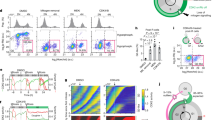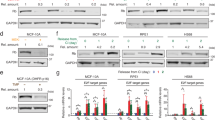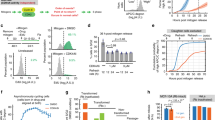Abstract
The transition from cellular quiescence (G0) into S phase is regulated by the mitogenic-activation of D-type cyclins and cyclin-dependent kinases (Cdks), the sequestration of the Cdk inhibitors (CDKIs), p21 and p27, and the hyperphosphorylation of Rb with release of E2F transcription factors1,2. However, fibroblasts that lack all D-type cyclins can still undergo serum-induced proliferation3 and key E2F targets are expressed at stable levels despite cyclical Rb–E2F activity1. Here, we show that serum induces expression of the Ets transcription factor, Gabpα, and that its ectopic expression induces quiescent cells to re-enter the cell cycle. Genetic disruption of Gabpα prevents entry into S phase, and selectively reduces expression of genes that are required for DNA synthesis and degradation of CDKIs, yet does not alter expression of D-type cyclins, Cdks, Rb or E2Fs. Thus, GABP is necessary and sufficient for re-entry into the cell cycle and it regulates a pathway that is distinct from that of D-type cyclins and CDKs.
This is a preview of subscription content, access via your institution
Access options
Subscribe to this journal
Receive 12 print issues and online access
$209.00 per year
only $17.42 per issue
Buy this article
- Purchase on Springer Link
- Instant access to full article PDF
Prices may be subject to local taxes which are calculated during checkout





Similar content being viewed by others
References
Dyson, N. The regulation of E2F by pRB-family proteins. Genes Dev. 12, 2245–2262 (1998).
Sherr, C. J. & Roberts, J. M. CDK inhibitors: positive and negative regulators of G1-phase progression. Genes Dev. 13, 1501–1512 (1999).
Kozar, K. M. et al. Mouse development and cell proliferation in the absence of D-cyclins. Cell 118, 477–491 (2004).
Hsu, T., Trojanowska, M. & Watson, D. K. Ets proteins in biological control and cancer. J.Cell Biochem. 91, 896–903 (2004).
Rosmarin, A. G., Resendes, K. K., Yang, Z., McMillan, J. N. & Fleming, S. L. GA-binding protein transcription factor: a review of GABP as an integrator of intracellular signaling and protein-protein interactions. Blood Cell Mol. Dis. 32, 143–154 (2004).
LaMarco, K., Thompson, C. C., Byers, B. P., Walton, E. M. & McKnight, S. L. Identification of Ets- and notch-related subunits in GA binding protein. Science 253, 789–792 (1991).
Luo, M. et al. Characterization and localization to chromosome 7 of ψhGABPα, a human processed pseudogene related to the ets transcription factor, hGABPα. Gene 234, 119–126 (1999).
Brown, T. A. & McKnight, S. L. Specificities of protein–protein and protein–DNA interaction of GABPα and two newly defined ets-related proteins. Genes Dev. 6, 2502–2512 (1992).
Ristevski, S. et al. The Ets transcription factor GABPα is essential for early embryogenesis. Mol. Cell Biol. 24, 5844–5849 (2004).
Resendes, K. K. & Rosmarin, A. G. Interaction between GABPα pointed domain and p300 mediates retinoic acid induced transcriptional activation of CD18 in myeloid cells. Mol. Cell Biol. 26, 3060–3070 (2006).
Rudge, T. L. & Johnson, L. F. Synergistic activation of the TATA-less mouse thymidylate synthase promoter by the Ets transcription factor GABP and Sp1. Exp. Cell Res. 274, 45–55 (2002).
Izumi M. et al. Transcription of the catalytic 180-kDa subunit gene of mouse DNA polymerase α is controlled by E2F, an Ets-related transcription factor, and Sp1. Biochim. Biophys. Acta. 1492, 341–352 (2000).
Imaki, H. et al. Cell cycle-dependent regulation of the Skp2 promoter by GA-binding protein. Cancer Res. 63, 4607–4613 (2003).
Nishikawa, N. S., Izumi, M., Yokoi, M., Miyazawa, H. & Hanaoka, F. E2F regulated growth-dependent transcription of genes encoding both the catalytic and regulatory subunits of mouse primase. Genes to Cells 6, 57–70 (2001).
Carter, R. S., Bhat, N. K., Basu, A. & Avadhani, N. G. The basal promoter elements of murine cytochrome c oxidase subunit IV gene consist of tandemly duplicated ets motifs that bind to GABP-related transcription factors. J. Biol. Chem. 267, 23418–23426 (1992).
Sucharov, C., Basu, A., Carter, R. S. & Avadhani, N. G. A novel transcriptional initiator activity of the GABP factor binding ets sequence repeat from the murine cytochrome c oxidase Vb gene. Gene Expr. 5, 93–111 (1995).
Villena, J. A. et al. Regulation of mitochondrial biogenesis in brown adipose tissue: nuclear respiratory factor-2/GA-binding protein is responsible for the transcriptional regulation of the gene for the mitochondrial ATP synthase beta subunit. Biochem. J. 331, 121–127 (1998).
Virbasius, J. V. & Scarpulla, R. C. Activation of the human mitochondrial transcription factor A gene by nuclear respiratory factors: a potential regulatory link between nuclear and mitochondrial gene expression in organelle biogenesis. Proc. Natl Acad. Sci. USA 91, 1309–1313 (1994).
Genuario, R. R., Kelley, D. E. & Perry, R. P. Comparative utilization of transcription factor GABP by the promoters of ribosomal protein genes rpL30 and rpL32. Gene Expression 3, 279–288 (1993).
Fingar, D. C., Salama, S., Tsou, C., Harlow, E. & Blenis, J. Mammalian cell size is controlled by mTOR and its downstream targets S6K1 and 4EBP1/eIF4E. Genes Dev. 16, 1472–1487 (2002).
Carrano, A. C., Eytan, E., Hershko, A. & Pagano, M. SKP2 is required for ubiquitin-mediated degradation of the CDK inhibitor p27. Nature Cell. Biol. 1, 193–199 (1999).
Yu, Z. K., Gervais, J. L. & Zhang, H. Human CUL-1 associates with the SKP1/SKP2 complex and regulates p21CIP1/WAF1 and cyclin D proteins. Proc. Natl Acad. Sci. USA 95, 11324–11329 (1998).
Nakayama, K. et al. Targeted disruption of Skp2 results in accumulation of cyclin E and p27Kip1, polyploidy and centrosome overduplication. EMBO J. 19, 2069–2081 (2000).
Helin, K. Regulation of cell proliferation by the E2F transcription factors. Curr. Opin. Genet. Dev. 8, 28–35 (1998).
Harbour, J. W. & Dean, D. C. The Rb/E2F pathway: expanding roles and emerging paradigms. Genes Dev. 14, 2393–2409 (2000).
Miyazawa, H. et al. Molecular cloning of the cDNAs for the four subunits of mouse DNA polymerase alpha-primase complex and their gene expression during cell proliferation and the cell cycle. J.Biol.Chem. 268, 8111–8122 (1993).
Navalgund, L. G., Rossana, C., Muench, A. J. & Johnson, L. F. Cell-cycle regulation of thymidylate synthetase gene expression in cultured mouse fibroblasts. J.Biol.Chem. 255, 7386–7390 (1980).
Wei, W. et al. Degradation of the SCF component Skp2 in cell-cycle phase G1 by the anaphase-promoting complex. Nature 428, 194–198 (2004).
Rosmarin, A. G., Caprio, D. G., Kirsch, D. G., Handa, H. & Simkevich, C. P. GABP and PU.1 compete for binding, yet cooperate to increase CD18 (β2 leukocyte integrin) transcription. J. Biol. Chem. 270, 23627–23633 (1995).
Attardi, L. D., Vries, A. & Jacks, T. Activation of the p53-dependent G1 checkpoint response in mouse embryo fibroblasts depends on the specific DNA damage inducer. Oncogene 23, 973–980 (2004).
Acknowledgements
We thank: R. Mortensen (University of Michigan, Ann Arbour, MI) for the pLNCL targeting plasmid; J. Sedivy (Brown University, Providence, RI) for advice on targeting construct strategy; T. Nottoli (Yale University, New Haven, CT) for assistance in generation of floxed Gabpa mice; J. Singer (Brown University) for pBabe–Cre; K.-U. Wagner (University of Nebraska, Omaha, NE) for the retroviral DNA pBabe; J. Foster (University of Tennessee, Knoxville, TN) for the Adeno–Skp2 virus; T. Jacks (Massachussetts Institute of Technology, Cambridge, MA) for Rb−/− MEFs; S. Fleming (Millennium Pharmaceuticals, Cambridge, MA) for technical assistance; E. Sabo (Rhode Island Hospital, Providence, RI) for imaging assistance; and E. Chin and J. Singer (Brown University), J. Licht (Northwestern University, Chicago, IL), D. Tenen (Harvard Medical School, Boston, MA), and members of the Rosmarin laboratory for critical reading of the manuscript. This work was supported by 1R01HL073945, and the following National Institutes of Health (NIH) COBRE Awards: P20 RR15578 (Brown University), 1P20RR017695 (Lifespan, Providence, RI), and 1P20RR018757 (Roger Williams Medical Center, Providence, RI) to A.G.R. Z.-F.Y. is supported by the Herbert W. Savit '49 Fund (Brown University).
Author information
Authors and Affiliations
Corresponding author
Ethics declarations
Competing interests
The authors declare no competing financial interests.
Supplementary information
Supplementary Information
Supplementary figures S1, S2, S3 and S4 (PDF 264 kb)
Rights and permissions
About this article
Cite this article
Yang, ZF., Mott, S. & Rosmarin, A. The Ets transcription factor GABP is required for cell-cycle progression. Nat Cell Biol 9, 339–346 (2007). https://doi.org/10.1038/ncb1548
Received:
Accepted:
Published:
Issue Date:
DOI: https://doi.org/10.1038/ncb1548
This article is cited by
-
Host proteome linked to HPV E7-mediated specific gene hypermethylation in cancer pathways
Infectious Agents and Cancer (2020)
-
GABPA is a master regulator of luminal identity and restrains aggressive diseases in bladder cancer
Cell Death & Differentiation (2020)
-
Expression Profiling of Blood microRNAs 885, 361, and 17 in the Patients with the Parkinson’s disease: Integrating Interaction Data to Uncover the Possible Triggering Age-Related Mechanisms
Scientific Reports (2019)
-
Regulatory Architecture of the Neuronal Cacng2/Tarpγ2 Gene Promoter: Multiple Repressive Domains, a Polymorphic Regulatory Short Tandem Repeat, and Bidirectional Organization with Co-regulated lncRNAs
Journal of Molecular Neuroscience (2019)
-
GABPA predicts prognosis and inhibits metastasis of hepatocellular carcinoma
BMC Cancer (2017)



